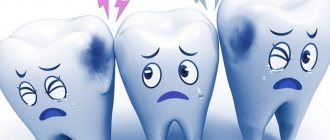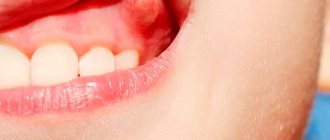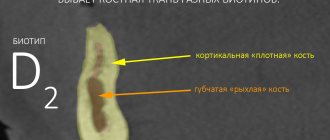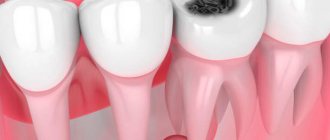Children's teeth appear in a certain sequence and in pairs (for example, two central incisors or two canines). But often the timing of teething in children shifts upward: many parents begin to worry and get nervous, but this is not worth doing, since the deviation from the norm is explained by the individual characteristics of the body, the uncharacteristic course of pregnancy, or various injuries received during childbirth.
Teething in children and features of this process
Quite often, a few weeks before the appearance of a baby or molar tooth, a lump filled with a clear or bluish liquid forms on the gum. Naturally, it worries parents, but there is no pathology in this formation, and the lump, which does not look very aesthetically pleasing, does not indicate the beginning of the inflammatory process. In most cases, no intervention by a doctor is required. You can contact the dentist if the lump increases in size: the doctor will make a small incision and release the liquid.
Baby teeth in children: order of eruption
Any newborn baby has follicles of milk teeth (20 pieces) and molars (16 pieces) inside the jaws. The remaining 16 rudiments will form later.
Teething in infants begins with the lower jaw: first the central incisors appear (6-10 months of the child’s life), then the canines (10-13 months), then comes the turn of the first (14-18 months) and second (17-23 months) molars .
Emerging teeth differ from adult teeth in having low-mineralized enamel. If you do not maintain oral hygiene, caries may begin to develop. In addition to careful adherence to hygiene rules, special gels and ointments that significantly accelerate the mineralization process will help make teeth stronger and more resistant to pathogenic microorganisms.
Location
The eye teeth or canines are found in pairs on the upper and lower jaws. They occupy an intermediate position between the front and back teeth, adjacent to the lateral incisors and molars (in the primary dentition) or small molars (in the permanent dental set).
The formation of primary eye teeth begins in the second month of embryogenesis. Like other teeth, they originate from the dental lamina of the oral epithelium, but penetrate into the developing bone tissue somewhat deeper than the others. The development of permanent canines and the entire set of molars begins a little later (at about 4 months of intrauterine development), but occurs identically to the formation of baby teeth.
The canines are characterized by the following features that distinguish them from other teeth:
- The presence of a single fairly long root, which is somewhat compressed on the sides.
- A massive crown with 2 cutting edges converging at an acute angle.
- The crown has a somewhat flattened shape, in which the labial and lingual surfaces meet at the cutting edge.
- The upper canine is slightly larger than the lower one, it has a longer cutting edge and wider contact surfaces.
Such features in the location and structure of the eye teeth allow them to perform their main function well: holding food and tearing it into pieces.
Approximate timing of eruption of permanent teeth
The first of the molar permanent teeth to appear are molars (at the 6th year of life), located at the end of the dentition. But it is they who are most susceptible to caries, since there are deep depressions on their surface where bacteria accumulate due to poor cleaning and neglect of flossing.
The second molar appears 4-6 years later, when the child reaches 11-13 years of age. Incisors erupt at 6-8 years of a person’s life, canines - after 9 years of age.
Like newly emerged milk teeth, permanent teeth contain few minerals (a tenth of their amount in a mature adult). It is for this reason that it is important to teach a child proper hygiene. It wouldn’t hurt to treat your teeth with gels containing a large amount of fluoride once a quarter.
What teeth are called eye teeth?
Eyeteeth is a folk term, not a medical one. In common parlance, this is usually what the upper canines are called, and by analogy with them, the lower ones too.
Probably, the fangs received their special name due to the fact that next to them there are branches of the facial nerve, when irritated, severe pain occurs, spreading to the upper half of the face and radiating into the eyes. That is why, when a child develops baby eye teeth, it is accompanied by excruciating pain and other unpleasant symptoms. And because of this, removing fangs in adults is a very painful procedure that requires serious anesthesia.
Despite their name, eye teeth do not affect vision in any way. Although quite often dental patients express the opinion that if a fang is removed they can easily go blind, such a prejudice has no medical evidence and is erroneous.
Teething in children: symptoms
The first signs of the imminent appearance of teeth appear about a week before their appearance. The symptoms will not stop until the tooth breaks through the gum lining.
Signs of teething in a baby are as follows:
- the child becomes irritable for no reason;
- sleep deteriorates (if the child cries at night and tosses and turns, there is no need to immediately start rocking him to sleep - it is better to give the baby the opportunity to calm down on his own);
- the gums become very swollen and swell at the site where the tooth appears;
- the appetite deteriorates, the baby may even refuse to eat altogether, feeling hungry;
- the child begins to chew on various objects to relieve severe itching in the gums;
- salivation increases;
- Due to drooling, a rash may appear around the mouth, chin and chest.
There are also additional ones, i.e. optional symptoms of teething in infants:
- heat. If the temperature has increased, this most likely indicates an inflammatory process that develops in parallel with teething and is in no way connected with it (it could be stomatitis or any cold).
When the temperature rises, you need to carefully examine the oral mucosa. If there are small bubbles filled with a cloudy liquid, erosion, and the gums themselves are bright red, then the child has herpetic stomatitis. Any baby receives antibodies to the herpes virus from its mother, but usually by the time the first teeth appear, their effect ends. Often the catalyzing factor in the development of stomatitis is trauma to the mucous membrane, which is inevitable when teeth appear. If the above signs cannot be detected, then it is recommended to give the baby Panadol (suppositories are the preferred form of medication). As practice shows, it is useless to call a pediatrician, since this is not their specialization. Only a dentist can determine the specific type of stomatitis (aphthous, herpetic, etc.).
- hematomas on the gums. Sometimes the gums become swollen, turning an eerie shade of blue. Despite their frightening appearance, hematomas do not require treatment. Doctor intervention is allowed only for large hematomas that do not decrease over a long time.
- vomit. The only acceptable cause of vomiting is excess saliva entering the stomach and esophagus. If vomiting begins against the background of elevated temperature and, especially, diarrhea, then these symptoms have nothing to do with teething - you need to call a doctor.
- coughing is not a natural cause when teeth appear, unless the child has swallowed saliva that has entered the respiratory tract.
- A runny nose is a sign of a cold, not teething.
How to help your baby
If a baby starts teething at 2 months, in addition to fatigue due to sleepless nights, parents feel worried about their baby. Since he suffers from pain, discomfort, eats little and sleeps poorly, it is necessary to help relieve unpleasant symptoms. To do this, use the following methods:
- Massage the gums. You must first wash your hands thoroughly. The massage is done with the tip of your finger. It is worth trimming your nails to avoid damaging your gums. Massaging helps relieve pain. The degree of effectiveness of the method can be determined by the child’s reaction.
- Cold is applied. Regular teethers, which are sold in pharmacies and offered to older children, will not be chewed by a baby at the age of two months. In this case, he can cool the pacifier or apply a gauze pad to the problem area. It is pre-moistened with cold water or chamomile infusion, which helps relieve inflammation.
- Lubricate the gums with anesthetic gels. For example, “Kamistad” or “Kalgel” are products that can be used even at an early age.
- They give antipyretic and painkillers based on ibuprofen and paracetamol. Candles are given to 2-month-old babies. This could be, for example, “Efferalgan”.
During the teething period, it is important to provide the baby with proper care. It is necessary to keep the pacifier clean. Saliva should be wiped off only with clean napkins. The skin around the mouth should be lubricated with a special baby cream. You also need to walk more - fresh air will only do you good. But it is better to avoid places with large crowds of people so that the baby does not catch an additional virus.
If a child’s teeth appear early, if he is breastfed, it is worth visiting a dentist. The fact is that the risk of developing bottle caries in this case is quite high.
Caring for children's teeth
The pattern of teething in children determines the approximate time of their appearance, but it is necessary to start observing oral hygiene as early as possible, without waiting for the teeth to erupt.
Breasts cannot take care of themselves, so they need help cleaning their gums. This is done either with the help of a fingertip, or, if there is none, with the help of an ordinary bandage dipped in warm boiled water and wound around the finger.
If teeth begin to erupt, you cannot do without the use of special products (baby pastes, brushes, etc.).
Why is inflammation of the gums near the teeth dangerous?
Childhood gingivitis develops very quickly, since there are many prerequisites for this - from child abuse of sweets to insufficient oral hygiene. After the start of the process, the volume of actively multiplying pathogenic microflora quickly increases. On the second or third day, you can already notice the first signs of beginning mucosal erosion. If you do not seek help at this time and start the disease, the already matured child will suffer from gum problems all his life and may lose his teeth prematurely.
Types of teething disorders
Teething in children, the sequence of which is clearly defined, can occur with a delay caused by various reasons (illness of the mother during pregnancy, diseases suffered by the child, etc.). Due to the delay, deformation of the jaws may begin, because There is not enough free space for teeth that have not yet erupted. In this case, only the dentist can decide on treatment after a thorough visual examination of the child and analysis of the photograph taken.
The next very common disorder is enamel hypoplasia, which manifests itself in spots of different colors on newly emerging teeth, pits or grooves. Hypoplasia causes complications during pregnancy.
If your temperature rises...
The teething of fangs in children should not be taken as a disease or a serious deviation. Photos of babies prove that this is a completely natural function of the body. In this condition, an increase in temperature is extremely rare, but not excluded. If the fever persists for several days and causes discomfort, you should call your local pediatrician.
An experienced doctor will be able to distinguish a cold from teething only by visual signs. Typically, doctors recommend lowering the temperature only if it exceeds 38 degrees. Not all medications are suitable for this, so self-medication is unacceptable. From the approved ones, it is recommended to choose those drugs whose effect has already been tested on the baby’s body. The following deserve special attention:
- "Paracetamol".
- "Ibufen."
- "Nurofen".
- "Cefekon".
The temperature during teething in children can persist for several days. If the fever does not go away more than three days after the start of treatment, you need to call the doctor again.
Why do teeth erupt with irregularities?
The condition of a child’s teeth in the first years of life depends on the health of the mother during pregnancy. The formation of hard dental tissues may be disrupted if a woman:
- suffered from toxicosis at the initial stage of pregnancy;
- experienced severe prolonged stress;
- was treated for kidney disease;
- suffered from rubella.
In addition to maternal diseases, the maturation of teeth and the development of the jaw system can be affected by:
- fetal prematurity or, conversely, delayed birth;
- conflict of Rh factors;
- sepsis suffered by a child in the first month of life;
- frequent colds, pneumonia;
- convulsions;
- toxicosis;
- refusal to breastfeed.
Often, parents, driven by the best intentions, want to alleviate the baby’s suffering by giving him medications. You must understand that any medicine, even if it seems completely safe, cannot be taken without consulting a pediatrician!
How to relieve your baby's condition with medications
If your baby is bothered by sore gums and begins to behave restlessly, you can give him a mild pain reliever that is appropriate for his age.
For the youngest, it is better to use candles, and older children can be given a special suspension. These drugs, in addition to a sedative effect, have mild antipyretic properties. In addition, pharmacies sell a special anesthetic gel, a small amount of which should be applied to the surface of the inflamed gum. However, you should not get carried away with such gels, since most of them promote increased salivation and also cause numbness, which makes the baby feel uncomfortable.
Important:
Before purchasing one or another medication to alleviate a child’s teething condition, you should definitely consult a pediatrician to rule out side effects.











